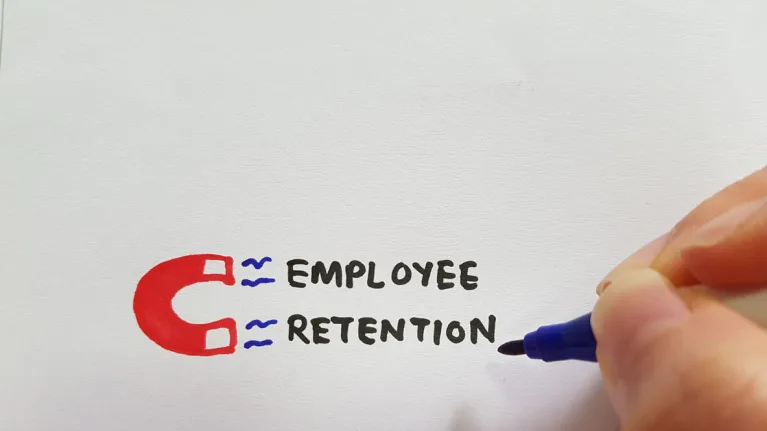Understanding and Addressing Employee Disengagement in Companies
 Omer Usanmaz
·
6 minute read
Omer Usanmaz
·
6 minute read
Companies strive to cultivate a productive and engaged workforce in the dynamic corporate landscape. However, the specter of disengaged employees can loom over even the most ambitious organizations, hindering growth, innovation, and employee satisfaction.
Companies must identify the symptoms of employee disengagement and comprehend its effects if they want to create a productive workplace. Moreso, by finding ways to navigate employee disengagement, businesses can address disengagement head-on and unlock the true potential of their teams.
Here, we’ll explore the signs of employee disengagement, how to measure employee engagement levels, and the benefits of conducting engagement surveys. One of the ways we will touch on is employee mentorship, which is how Qooper comes in.
How?
Keep reading to find out.
Who is a disengaged employee or leader?
Before we get into how to sort this problem for content, here is a simple definition of a disengaged employee or leader:
A disengaged employee or leader needs more enthusiasm, motivation, and commitment toward their work or the organization. They may display a lack of interest, contribute minimal effort, and exhibit a disconnection from team goals. Disengaged individuals often fail to inspire or drive their teams, impacting overall productivity and morale.
What are the signs of employee disengagement?
Employee disengagement can manifest in various ways, and awareness of the signs of disengagement is vital to proactively addressing the issue. Watch out for employees who exhibit the following:
- Lack of motivation, enthusiasm, and a bad attitude toward their work.
- Decreased productivity and quality of work.
- Lack of engagement, limited initiative, or proactive behavior on a regular basis.
- Minimal levels of employee engagement and participation in team discussions and activities.
- Lack of interest in personal or professional development opportunities.
- Absenteeism or frequent tardiness.
- Unhealthy behaviors like poor communication and refusing to collaborate with colleagues.
- Indifference towards company goals and values.
- Need more effort to provide innovative ideas or suggestions.
- Increased complaints or negative attitudes towards work or the organization.
What factors contribute to disengagement?
Several factors contribute to unhappy employees. Here are the common ones:
- A lack of clear goals, action plans, and expectations leaves employees uncertain about their organizational roles and purpose.
- Employee disengagement can also result from not rewarding and the lack of recognition of staff work since they may feel unappreciated and devalued.
- Employees may become disengaged due to low potential for career growth, a lack of resources, or a lack of opportunity for professional development.
- Ineffective communication and a lack of transparency foster a climate of mistrust.
- A toxic workplace culture characterized by ineffective leadership, favouritism, or lack of support, can further contribute to employee disengagement.
- Occasional stress, burnout, and personal issues can also have a negative impact on disengaged workers.
Addressing these factors fosters engagement and creates a thriving work environment.
How can companies measure employee engagement levels?
Measuring employee engagement levels is essential to gain insights into the workforce’s health. Here are some ways to do that:
Employee Engagement Surveys: Businesses may get direct input from their workforce by regularly conducting surveys. These surveys provide valuable insights and key indicators of why an employee disengages by asking relevant questions about job satisfaction, work environment, and communication.
Pulse Surveys: These shorter, more frequent surveys provide real-time snapshots of detached employees. By regularly checking the pulse of the workforce, companies can stay updated on engagement levels and quickly address emerging issues. Pulse surveys can focus on specific topics or themes, allowing for targeted interventions.
Employee Feedback Channels: Establishing open and transparent communication channels, such as suggestion boxes, suggestion platforms, or regular feedback sessions, encourages dialogue around employees to share their thoughts and concerns. These channels enable companies to gather qualitative feedback and better understand the reasons behind a dissatisfied employee.
Performance Reviews: Integrating employee engagement-related questions into performance reviews allows one to evaluate engagement levels. Assessing factors like enthusiasm, initiative, and collaboration during these reviews offers insights into individual and team engagement, aiding in identifying areas for improvement.
Absenteeism and Turnover Rates: Monitoring lateness, absenteeism, and employee turnover rates can have a direct impact to reflect employee engagement levels where various employee engagement strategies can be applied. High absence or turnover rates could be signs of disengagement or unhappiness. Analyzing these metrics can prompt companies to investigate the underlying causes and implement appropriate measures.
Social Network Analysis: Analyzing the informal social networks within the organization can provide insights into employee engagement. Mapping relationships, communication patterns, and collaboration can reveal hidden dynamics and help identify engaged employees who serve as influencers or connectors.
What advantages do conducting engagement surveys offer?
Conducting engagement surveys offers numerous benefits for companies and employees alike.
Your staff believes they have a voice
First and foremost, anonymous platforms for employees to voice their ideas, worries, and suggestions are offered through engagement surveys. Ensuring that every voice is heard promotes inclusivity and empowerment among employees. By soliciting feedback on various aspects such as company culture, values, growth opportunities, and workplace satisfaction, companies can gain actionable insights into the factors that impact employee engagement.
You can recognize patterns and slots for improvement
Organizations can spot trends, patterns, and areas for improvement by examining survey results. Keywords like “employee feedback” and “employee engagement levels” enable companies to pinpoint specific challenges, address them promptly, and implement targeted interventions.
They can serve as a diagnostic aid
Moreover, engagement surveys act as a diagnostic tool, allowing companies to gauge the effectiveness of existing engagement strategies and track progress over time.
Engagement surveys contribute to data-driven decision-making, allocating resources, prioritizing initiatives, and informing strategies. By addressing areas of concern, companies can improve employee satisfaction, productivity, and retention, resulting in keywords such as “increased productivity,” “job satisfaction,” and “workplace satisfaction.”
What are the repercussions of having a team of disengaged employees?
A team of disengaged employees can have several detrimental repercussions for the organization.
- Firstly, productivity and efficiency suffer as disengaged employees tend to exhibit lower motivation, resulting in decreased output and quality of work.
- Collaboration and teamwork are hindered as disengaged team members are less likely to contribute or participate in group efforts actively.
- Morale and employee satisfaction decline, leading to increased absenteeism, turnover, and difficulty attracting and retaining top talent.
- Disengaged employees can spread negativity and discontent within the team, impacting overall team dynamics and hindering innovation and growth that may cause quiet quitting.
If you do nothing to address this, your business may fail.
What are some ways to fix the problem of having disengaged employees?
If you want to reverse the attitude disengaged employees display, here are some ways to do just that:
- Mentorship Programs: Implementing mentorship programs where experienced employees can guide and support disengaged team members can help re-engage them. Mentors can provide individualized feedback, promote skills development, and foster an environment conducive to progress. Using online platforms like Qooper can help you do that.
- Company Team Building: Organizing team-building activities and events that promote collaboration, trust, and camaraderie can re-ignite engagement. These activities allow workers to connect, form connections, and build a sense of community within the team.
- Clear Goals and Expectations: Communicating clear goals and expectations and providing regular feedback to disengaged employees can help them understand their roles. It also highlights their purpose within the organization so that they feel valued. Clarity fosters a sense of direction and motivation to contribute effectively.
- Training and Development Opportunities: Offering relevant training and development opportunities to disengaged employees can enhance their skills and provide a sense of growth and progression, increasing their engagement and commitment to the organization.
- Recognition and Rewards: Implementing a culture of recognition and rewards where employee contributions are acknowledged and celebrated can significantly boost engagement. Regularly acknowledging and appreciating their efforts can improve morale and motivation.
- Open Communication Channels: Creating open communication channels where employees feel comfortable expressing their concerns, providing feedback, and participating in decision-making can help address underlying issues and re-engage disengaged employees.
What are some ways that mentorship helps disengaged employees improve?
Mentorship can play a significant role in helping disengaged employees improve and regain their sense of purpose and motivation. Here are some ways mentorship can benefit disengaged employees:
Guidance and Support: Mentors provide personalized guidance, support, and encouragement to disengaged employees. Through one-on-one conversations, mentors can comprehend their worries, provide guidance, and assist them in overcoming obstacles.
Skill Development: Mentors can identify areas where disengaged employees need improvement and suggest relevant skill development opportunities. By guiding acquiring new skills or enhancing existing ones, mentors empower employees to grow professionally.
Increased Accountability: Mentors hold disengaged employees accountable for their actions and goals. By setting expectations and regularly checking progress, mentors help instil a sense of responsibility and commitment.
Building Confidence: Mentors boost the confidence of disengaged employees by recognizing their strengths and highlighting their achievements. Employee participation and active contribution are encouraged by this validation, which aids in regaining self-confidence.
Perspective and Feedback: Mentors offer a fresh perspective and provide constructive feedback to disengaged employees. Their insights can help individuals gain new insights, identify blind spots, and explore alternative approaches.
Encouragement of Autonomy: Mentors give disengaged workers the tools they need to take responsibility for their job and exercise autonomy. Mentors help individuals regain control and fulfillment in their roles by fostering autonomy.
Final thoughts
Employee disengagement can have a direct negative impact on your company’s success and employee well-being. Recognizing the signs, understanding the factors contributing to disengagement, and taking proactive measures are crucial for creating a thriving work environment.
Mentorship programs, like Qooper, can provide valuable support in addressing employee disengagement. Qooper offers online mentorship programs that connect employees with experienced mentors who can guide, inspire, and re-engage disengaged employees.
If you’re ready to tackle employee disengagement head-on, schedule a demo with Qooper today to explore how their mentorship programs can help your organization unlock the full potential of your workforce and foster a culture of engagement and growth. Start immediately by taking the first step towards a more engaged and motivated team.





